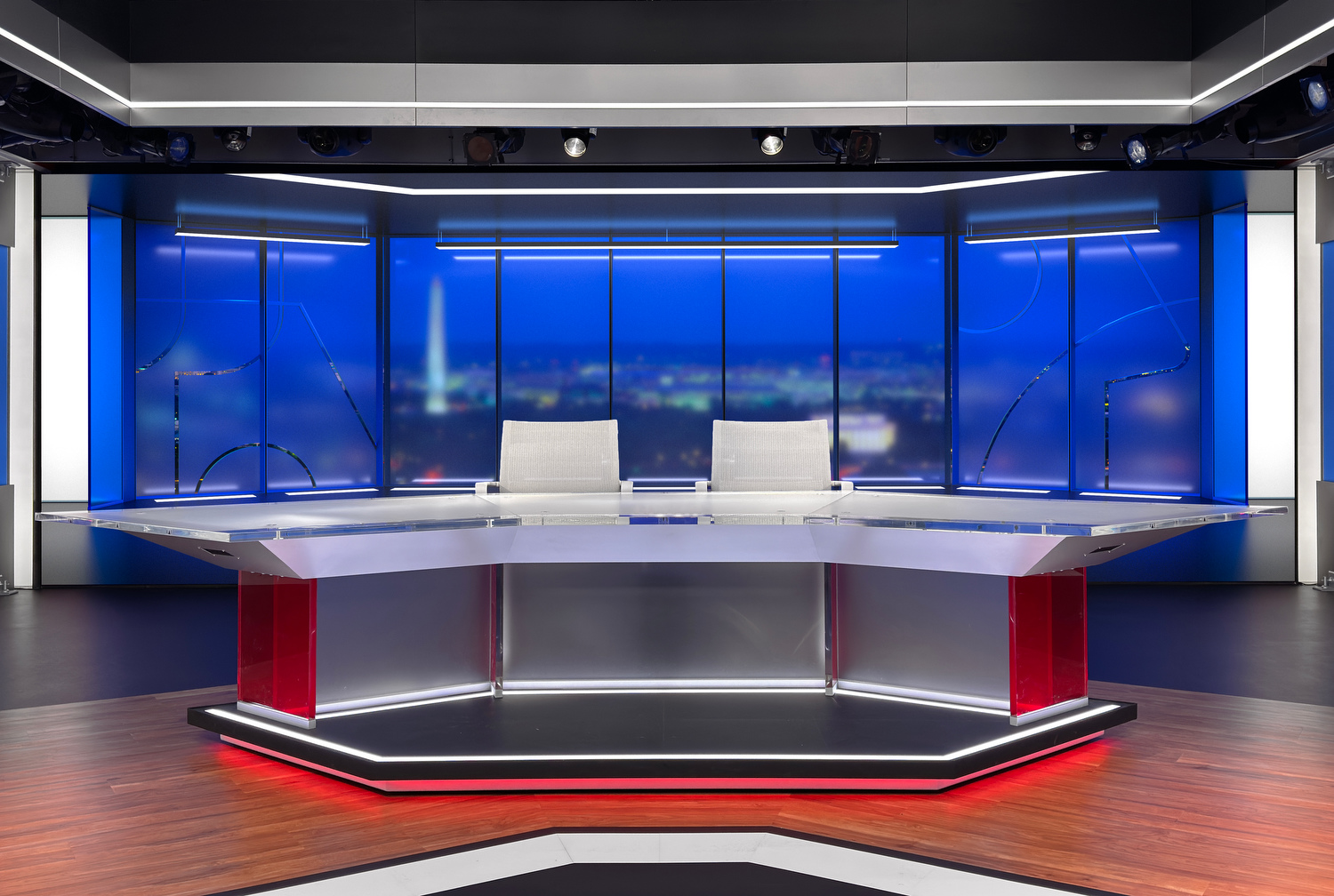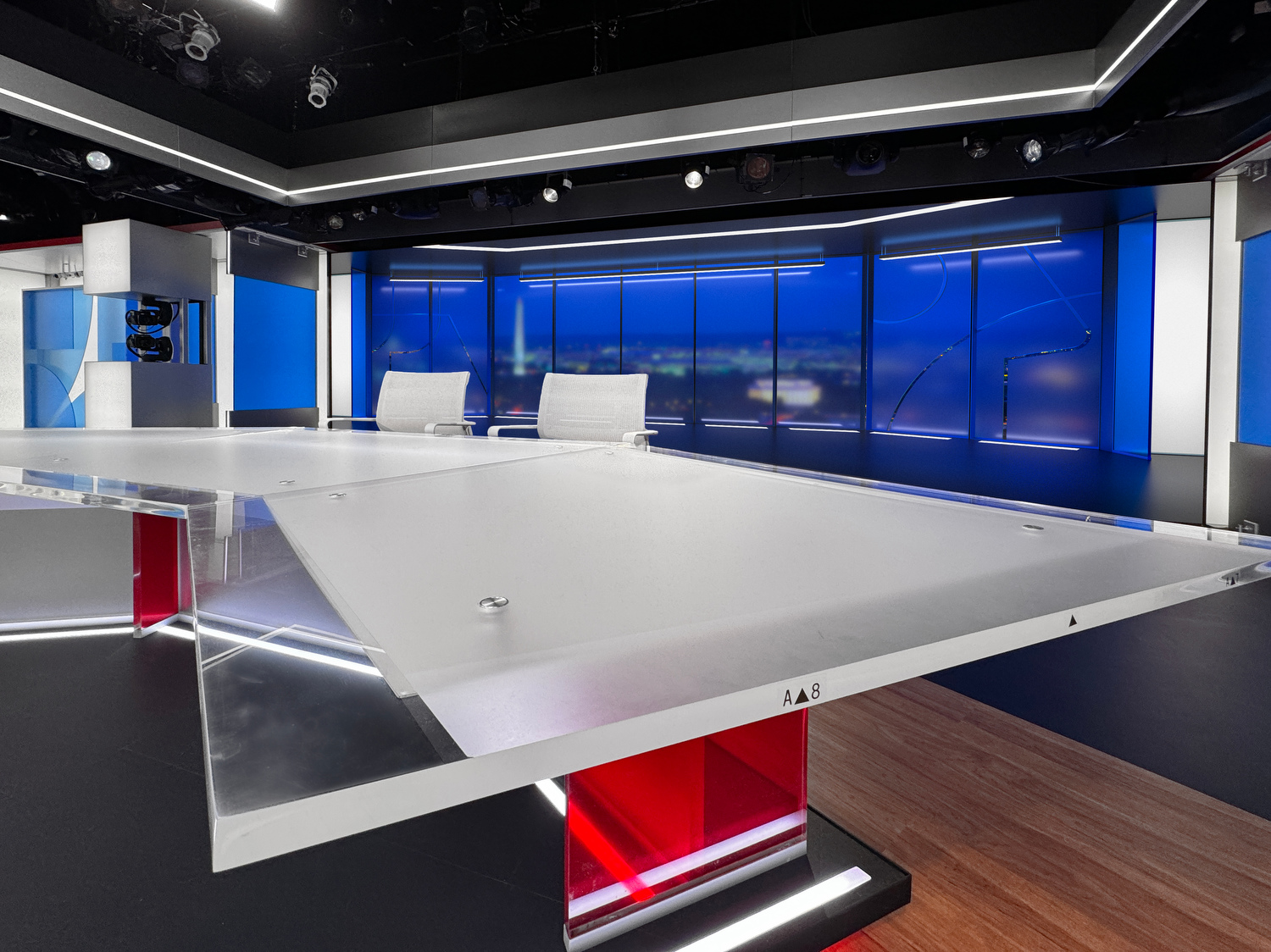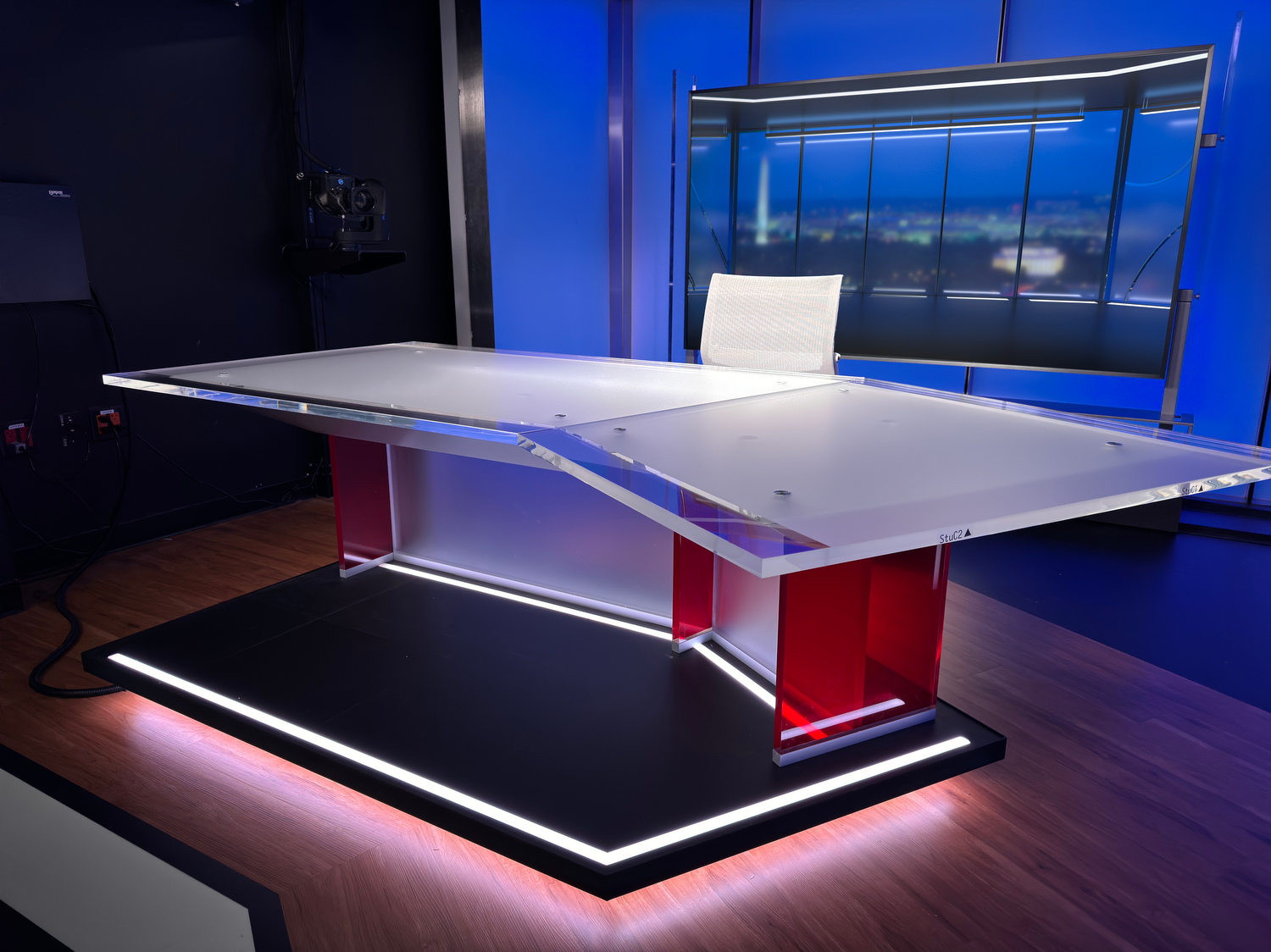‘PBS News Hour’ scales up aesthetic for sprawling new studio, facility

Subscribe to NCS for the latest news, project case studies and product announcements in broadcast technology, creative design and engineering delivered to your inbox.
Since unveiling its now-familiar design aesthetic in 2015, “PBS News Hour” has taken the next step in its evolution thanks to a newly expanded broadcast facility and updated motion graphics.
“The 2015 set was so well received that it was an easy decision to carry on the stylistic DNA they were composed of,” said designer Eric Siegel, ahead of the June 10, 2024, launch of the new studio, graphics, logo and rebranding as “PBS News” on its digital platforms.
“All the new set pieces were constructed using clean, airy, frosted acrylics with rich red accents, satiny metals, uprights of cool transparent blues held by custom metal fittings, and a floor pattern of white and wood for richness and warmth. Bright LED light stripes give the risers and the uprights life and punch,” he added.
The new set’s redesign coincides with the expansion of the WETA building in Arlington, Virginia, just outside of Washington, D.C.


A wide view of Studio A.
“News Hour” is produced by NewsHour Productions (a subsidiary of WETA) and distributed to PBS member stations nationwide.
Since the launch of “The Robert MacNeil Report,” the broadcast’s original name, in 1975, it and its sister show “Washington Week” (originally “Washington Week in Review”), the program has broadcast from a studio in a production center a few blocks from the main WETA building.
That building, which sits on Campbell Avenue, has now been expanded thanks to an addition constructed over a courtyard. This allowed WETA to create three new studios and overhaul the supporting technical facilities for them. Newsroom spaces for “News Hour” and “Washington Week” were also carved out of the expanded space.
Studio A is slated to be home to both shows thanks to a sprawling set created by Siegel and George Allison, who teamed on the 2015 set as well.
“News Hour” moves into the space June 10, 2024, with “Washington Week” moving later in June or early July 2024.
The centerpiece of the new space is a 25-foot LED wall created using 182 Absen 1.5mm tiles powered by an Analog Way image processor from integrator 4Wall Entertainment. For “News Hour,” this displays a virtual set extension that creates the illusion of the space having a wall of frosted glass in front of a nighttime view of Washington, D.C., as seen from Arlington.
There are also options to insert a variety of virtual horizontal and vertical monitors camera center.
Over 270 degrees of the studio is wrapped in backlit walls with color-changing LED backlighting. For “News Hour,” the clean, fresh white achieved with a cyc at the old studio is recreated with one lighting cue, while plans call for “Washington Week” to get a richer look.
Gaps in the simulated frost in the VSE draw on the shapes from the iconic “everyman” logo, which the organization refreshed in 2019. At the same time, it also introduced a custom font, known as PBS Sans, which has become the basis of a new “News Hour” logo and motion graphics package.
The use of those panels hints at the freestanding shapes that created various background components of the old studio.


The new main anchor desk features a sleek off-white, frosted, red and glass desk and is spacious enough for guests or correspondents to join on either side. Wild extensions can be brought in to allow the desk to accommodate up to eight people total.
Inside the desk are built-in chin-fill uplights and integrated USB power ports, allowing talent to bring devices on-set without dragging along adapters or power bricks.
On either side of home base, the studio is outfitted with two distinct venues.
Both are complemented with an additional 14-foot video wall that can serve as either a background element or a way to bring remote guests or correspondents into the conversation.
By default, these LED walls sport blue and white backgrounds, inspired by the transparent everyman elements found at the old studio and mirroring the real ones installed upstage.


The first venue, set camera left, is designed primarily as an interview desk that can seat one anchor or correspondent and up to two guests. A movable 98-inch touchscreen allows for showcasing graphics and doubles as both a standup area and visual storytelling tool for interactive graphics, such as during political coverage.


Across the studio is a sit-down interview space with open seating, which can accommodate a host and up to two guests. The LED video wall here can also be configured to showcase live feeds from remote guests or correspondents.
The space also includes a 65-inch floating screen installed in front of a geometric sculptural wall with a smattering of none 10-inch displays. Below this is a credenza-style base with warm wood top and red accent panels.
A key difference in the new set is the ability to create more natural relationship shots — and that’s made possible by a variety of strategic decisions.
“It was clear from the start that achieving the needed coverage would be cumbersome using only large studio pedestal cameras,” explained Siegel.


To solve that, the studio has six Grass Valley cameras mounted on Vinten Vantage PTZ heads installed directly on the scenery.
Two internally-lit towers, custom engineered and fabricated by Boyce Products using the same materials found on the rest of the studio, can capture the studio from their “parked” positions inside of two “garages” flanked by custom vertical panels.
As an added benefit, the robotic camera operator can also directly the entire pillar to slide along an 8-foot track, bringing them farther out into the studio to expand the blocking options even more.
The two additional cameras are are installed near the internally-lit columns that serve as the terminus for the scenery on either side.
These columns mirror the traveling ones and are installed directly opposite them, with a metallic header element extending across the width of the space, creating a visual frame for the core portion of the set.
Lightboxes suspended from the ceiling further help define each space, including three mounted above the middle of the studio and two each in both side venues.


Meanwhile, floor finishes span out diagonally from the anchor desk, using wood and gray instead of the solid red used for similar markings in the old space. These then change directions near the two smaller video walls, flowing into each of the two side alcove spaces.
WETA once again worked with lighting designer Dennis Size from The Lighting Design Group. Along with co-designer Alex Kyle-Dipietropaolo, the company created a lighting plot with over 250 instruments.
30 of those are intelligent fixtures (GLP Impression FR1s and High End Lonestars). Also included in are 85 Prolights ECL Profile ellipsoidals, 30 Prolights ECL Panel softlights, 35 fresnels (both Practilite 634s and Elation KLs) along with fixtures from Chauvet, Chimera, Coemar, ElectraLite and Litepanels.
Lighting control is handled with ETC GIO Consoles paired with remote touch screen units.
In addition to Studio A, a scaled down version of the set accommodating a single anchor and up to two guests thanks to coverage of three robotic cameras, including two on peds and one on another Vinten head.
This set calls the smaller Studio C home (Studio B, which is the same size as Studio A, can be used for other WETA productions, including local shows).


In addition to a small array of backlit panels, a pivoting 98-inch display can serve as both a background or remote interview portal.
The show can create a similar look to the main studio by feeding an image of the VSE behind the position, though the space could also presumably be used for a variety of other simple productions or pre-taped segments, including as an insert-style facility.
Project credits
- Scenic design: Eric Siegel and George Allison
- Scenic fabrication: Boyce Products
- Lighting design: Dennis Size and Alex Kyle-Dipietropaolo for The Lighting Design Group
- Rigging and control systems design: Tony Siniscalco for The Lighting Design Group
- Production Gaffer and Programmer: Jon Goss for The Lighting Design Group
- Lighting Grid Fabrication: IWeiss
- AV integration: 4Wall Entertainment
- Facility design and integration: BeckTV
Subscribe to NCS for the latest news, project case studies and product announcements in broadcast technology, creative design and engineering delivered to your inbox.











tags
4Wall Entertainment, Absen, Alex Kyle-Dipietropaolo, Analog Way, BeckTV, BOYCE Products Ltd, Chauvet, Chimera Lighting, Coemar, dennis size, elation professional, ElectraLite, Eric Siegel, German Light Products, High End Systems, Litepanels, PBS, PBS News, PBS News Hour, PBS News Weekend, Practilite, Prolights, PTZ Cameras, robotic cameras, The Lighting Design Group, Video Walls, Vinten, Vinten Vantage, virtual set extensions, Washington Week with The Atlantic, weta
categories
Broadcast Facility Technology, Heroes, Set Design, Studio Technology